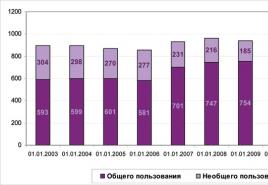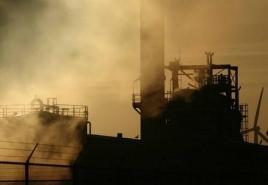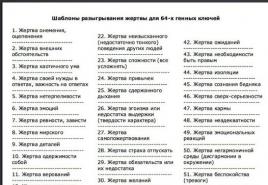Calculation of standards for permissible emissions of pollutants (NDV). Standards for emissions of pollutants into the atmosphere Standards for emissions of pollutants into the atmosphere
Industrial and economic development is accompanied, as a rule, by an increase in environmental pollution. Most large cities are characterized by a significant concentration of industrial facilities in relatively small areas, which poses a danger to human health.
One of the environmental factors that have the most pronounced impact on human health is air quality. Emissions into the atmosphere of pollutants present a particular danger. This is due to the fact that toxicants enter the human body mainly through the respiratory tract.
Air emissions: sources
Distinguish between natural and anthropogenic sources of pollutants entering the air. The main impurities that contain emissions into the atmosphere from natural sources are dust of space, volcanic and plant origin, gases and smoke generated as a result of forest and steppe fires, products of destruction and weathering of rocks and soils, etc.
Air pollution levels from natural sources are of a background nature. They change little over time. The main sources of pollutants entering the air basin at the present stage are anthropogenic, namely, industry (various industries), agriculture and motor transport.
Air emissions from enterprises
The largest "suppliers" of various pollutants to the air are metallurgical and energy enterprises, chemical production, construction industry, machine building.
In the process of burning fuel of various types by energy complexes, large amounts of sulfur dioxide, carbon and nitrogen oxides, and soot are emitted into the atmosphere. A number of other substances, in particular hydrocarbons, are also present in emissions (in smaller quantities).
The main sources of dust and gas emissions in metallurgical production are smelting furnaces, casting plants, pickling departments, sintering machines, crushing and grinding equipment, unloading and loading of materials, etc. The largest share of the total amount of substances released into the atmosphere is occupied by carbon monoxide, dust, sulfur dioxide, Nitric oxide. Manganese, arsenic, lead, phosphorus, mercury vapors, etc. are emitted in slightly smaller quantities. Also, in the process of steelmaking, atmospheric emissions contain steam-gas mixtures. They include phenol, benzene, formaldehyde, ammonia and a number of other hazardous substances.
Harmful emissions into the atmosphere from the industry, despite their small volumes, pose a particular danger to the natural environment and humans, since they are characterized by high toxicity, concentration and significant diversity. The mixtures entering the air, depending on the type of product produced, may contain volatile organic compounds, fluorine compounds, nitrous gases, solids, chloride compounds, hydrogen sulfide, etc.
In the production of building materials and cement, air emissions contain significant amounts of various dust. The main technological processes leading to their formation are grinding, processing of charges, semi-finished products and products in streams of hot gases, etc. Around factories producing various building materials, contamination zones with a radius of up to 2000 m can form. They are characterized by a high concentration of dust in the air containing particles of gypsum, cement, quartz, as well as a number of other contaminants.

Vehicle emissions
In large cities, a huge amount of air pollutants comes from vehicles. According to various estimates, they account for 80 to 95%. consist of a large number of toxic compounds, in particular nitrogen and carbon oxides, aldehydes, hydrocarbons, etc. (about 200 compounds in total).
The largest volumes of emissions are observed in areas where traffic lights and intersections are located, where cars move at low speed and at idle. Calculation of emissions into the atmosphere shows that the main components of emissions in this case are also hydrocarbons.

It should be noted that, unlike stationary sources of emissions, the operation of vehicles leads to air pollution on city streets at the height of human growth. As a result, pedestrians, residents of houses located near the roads, as well as vegetation growing in the adjacent territories are exposed to harmful effects of pollutants.
Agriculture
Impact on a person
According to various sources, there is a direct link between air pollution and a number of diseases. So, for example, the duration of the course of respiratory diseases in children who live in relatively polluted areas is 2-2.5 times longer than in those who live in other areas.

In addition, in cities characterized by an unfavorable environmental situation, children have functional deviations in the system of immunity and blood formation, violations of compensatory-adaptive mechanisms to environmental conditions. Many studies have also found a link between air pollution and human mortality.
The main components of air emissions from various sources are suspended solids, oxides of nitrogen, carbon and sulfur. It was revealed that zones with excess of MPCs for NO 2 and CO cover up to 90% of the urban area. These macrocomponents of emissions can cause serious diseases. The accumulation of these contaminants leads to damage to the mucous membranes of the upper respiratory tract, the development of pulmonary diseases. In addition, increased concentrations of SO 2 can cause degenerative changes in the kidneys, liver and heart, and NO 2 - toxicosis, congenital anomalies, heart failure, nervous disorders, etc. Some studies have revealed the relationship between the incidence of lung cancer and the concentrations of SO 2 and NO 2 in the air.

conclusions
Pollution of the natural environment and, in particular, the atmosphere, has adverse consequences for the health of not only the present, but also subsequent generations. Therefore, we can safely say that the development of measures aimed at reducing emissions of harmful substances into the atmosphere is one of the most pressing problems of mankind today.
Reading time: 11 minutes
Since 01.01.2019, permits for the emission of harmful (polluting) substances (VZV) into the atmospheric air (AB) are no longer issued, now the enterprises must have a document - the calculation of permissible emissions standards.
Frequently asked Questions
Previously obtained permits are valid for the period of validity of this permit, provided, of course, that the technological processes that lead to the release of pollutants into the AW are not changed
Valid for the period of validity of the permit.
Do I need to coordinate the calculation?
No, don't. The calculation is approved by the head of the enterprise.
Do I need to get a sanitary and epidemiological conclusion from Rospotrebnadzor?
It is necessary. Nobody canceled the sanitary and epidemiological legislation. Look at FZ-52, SanPiN 2.1.6.1032-01. There is an article on this issue on my website.
Are there requirements for drawing up the calculation of NDV?
Currently, no.
Ask a Question
Calculation of standards for permissible emissions from 01.01.2019 is necessary for enterprises 1, 2, 3 of the EIA category:
When planning the construction of facilities of categories 1 and 2 as part of an environmental impact assessment, it is also necessary to calculate the permissible emission standards.
The specified calculation is one of the appendices to for objects of the IIE category, for it is an integral part of an integrated environmental permit.
Primary for the calculation of permissible emissions standards - carrying out. As a result, all sources of atmospheric air at the enterprise will be identified and taken into account with the determination of indicators of airborne emissions, incl. to identify VZV 1, 2 hazard classes (relevant for EIA category 3).
There are currently no specific requirements for the design of the calculation of permissible emissions standards.
There is also no requirement for the approval of the specified calculation in government bodies.
One of the explanatory letters says that
The Ministry of Natural Resources and Environment of the Russian Federation considers it possible to present the results of calculations of permissible emission standards, permissible discharge standards according to the existing forms, provided for by the Administrative Regulations of the Federal Service for Supervision of Natural Resources for the provision of state services for issuing permits for emissions of harmful (polluting) substances into the air (with the exception of radioactive substances ), approved by order of the Ministry of Natural Resources of Russia dated 25.07.2011 N 650, and the Methodology for the development of standards for permissible discharges of substances and microorganisms into water bodies for water users, approved by order of the Ministry of Natural Resources of Russia dated 17.12.2007 N 333, respectively.
Responsibility for the lack of calculation of permissible emission standards
Previously, for the lack of permission to release VZV in AB, enterprises were involved under Part 1 of Article 8.21 of the Administrative Offenses Code of the Russian Federation, the punishment in the form of a fine for a legal entity ranged from 180 thousand rubles.
Currently, the Code of Administrative Offenses of the Russian Federation does not provide for a separate article for the lack of calculation of permissible emissions standards.
But there is Article 8.5 of the Code of Administrative Offenses of the Russian Federation, concerning the concealment, deliberate distortion or untimely communication of complete and reliable information in the declaration on the impact on the environment. This is relevant for Category 2 EIA. The fine for a legal entity is 20.0 thousand in the minimum amount.
For objects of the 1st category, for the absence of an integrated environmental permit, Article 8.47 of the Code of Administrative Offenses of the Russian Federation will be applied, which provides for liability for a legal entity in the minimum amount of 50.0 thousand rubles.
Emission Standards - Rationale
Article 22. Standards of permissible emissions, standards of permissible discharges
1. Standards of permissible emissions are determined for a stationary source and (or) a set of stationary sources in relation to pollutants included in the list of pollutants established by the Government of the Russian Federation, by calculation based on environmental quality standards, including standards for maximum permissible concentrations, taking into account the background state of natural Wednesday.
2. is carried out by legal entities and individual entrepreneurs planning the construction of objects of categories I and II (when conducting an environmental impact assessment), as well as carrying out economic and (or) other activities at objects of category II.
3. Calculation of standards of permissible emissions is an appendix to the declaration on the impact on the environment, submitted, respectively, to the federal executive body authorized by the Government of the Russian Federation, the executive body of the constituent entity of the Russian Federation in the manner prescribed by Article 31.2 of this Federal Law, except for the cases provided for in Article 23.1 of this Federal Law.
4. Standards of permissible emissions, with the exception of radioactive, highly toxic substances, substances with carcinogenic, mutagenic properties (substances of I, II hazard class) are not calculated for objects of III category.
5. Standards of permissible emissions are not calculated for objects of category IV.
6. Techniques and (or) methods for the development of standards for permissible emissions, standards for permissible discharges are approved by the federal executive body authorized by the Government of the Russian Federation.
(see text in previous edition)
1. For the purpose of state regulation of emissions of pollutants into the atmospheric air, the following are established:
(see text in previous edition)
maximum permissible emissions;
maximum permissible standards for harmful physical effects on the atmospheric air;
technological standards of emissions;
technical emission standards.
2. Maximum permissible emissions are determined in relation to pollutants, the list of which is established by the Government of the Russian Federation in accordance with the legislation in the field of environmental protection, for a stationary source and (or) a set of stationary sources by calculation based on atmospheric air quality standards, taking into account the background level of pollution atmospheric air.
(see text in previous edition)
2.1. When determining the maximum permissible emissions (with the exception of radioactive emissions), methods for calculating the dispersion of emissions of pollutants in the atmospheric air are used, approved by the federal executive body in charge of developing state policy and legal regulation in the field of environmental protection. The methods for the development and establishment of standards for maximum permissible emissions of radioactive substances into the atmospheric air are approved by the body authorized to exercise federal state supervision in the field of atomic energy use.
2.2. Programs for electronic computers used for calculating the dispersion of emissions of pollutants in the air (with the exception of emissions of radioactive substances) are subject to expertise, which is carried out by the federal executive body in the field of hydrometeorology and related areas, in order to recognize the compliance of these programs with the formulas and calculation algorithms included in the approved methods for calculating the dispersion of emissions of pollutants in the air.
Examination of a program for electronic computers used for calculating the dispersion of emissions of pollutants in the air (except for emissions of radioactive substances) is carried out at the expense of the rightholder of such a program in the manner established by the federal executive body responsible for the development of state policy and regulatory legal regulation in the field of environmental protection.
The examination of the program for electronic computers used for calculating the dispersion of emissions of radioactive substances in the atmospheric air is carried out in accordance with the legislation of the Russian Federation in the field of atomic energy use.
2.3. The background level of atmospheric air pollution is determined on the basis of data from the state monitoring of atmospheric air in accordance with the methodological instructions approved by the federal executive body responsible for the development of state policy and legal regulation in the field of environmental protection. If there are summary calculations of atmospheric air pollution on the territory of a settlement, part of it or on the territory of an industrial (industrial) park in relation to pollutants for which state monitoring of atmospheric air is not carried out, the background level of atmospheric air pollution is determined on the basis of data from summary calculations of atmospheric air pollution ...
Industrial air pollution levels have reached levels that seriously threaten human health. The main culprits are industry, transport, household boilers. The largest contribution to pollution is made by industrial enterprises.
Industrial sources of air pollution
The level of harmful impurities in the air increases in proportion to the size of the settlement - from negligible over villages to heavy smog over large cities. This is due to the congestion of vehicles and industrial enterprises in cities.
The following industrial production is the main source of air pollution:
- thermal power plants;
- nuclear industry enterprises;
- metallurgical plants;
- processing plants;
- chemical plants.
Waste is discharged by such enterprises on a regular basis. They constantly use liquid and solid fuels for their needs, which, when burned, emit toxic substances.
The use of high ash coal by thermal power plants leads to the formation of carbon dioxide and sulfur dioxide. Toxic waste from the nuclear industry is produced during the processing of nuclear fuel and its use in reactors. The waste of metallurgical plants has a diverse chemical composition - over a dozen different metals are found in them.
Types of harmful impurities
Industrial waste forms mixtures with oxygen (when vapor and gas are released) or aerosols (when solid and liquid particles are released). Aerosols are of several types:
- smoke - formed with the participation of small solid particles;
- dust - obtained from large solid particles;
- fog - formed by liquid particles.
The most dangerous form of emissions is radioactive dust, which leads to a significant deterioration in the state of the atmosphere. Over 150 million tons of dust per year are emitted during the production of cement, cast iron and coal combustion.

The highest air pollution is recorded in cities. The chemical composition of impurities is different, depending on the types of operating plants. The following substances are constantly present in the airspace over the city:
- sulfur dioxide, carbon monoxide and carbon dioxide;
- nitrogen oxides;
- fluorine and chlorine compounds;
- heavy metals.
Sulfur dioxide is produced during the combustion of sulfur-containing fuels, the processing of sulfur ores and takes part in the formation of acid rain. Carbon monoxide and carbon dioxide create a greenhouse effect. Nitrogen oxides are formed during all types of combustion, the production of fertilizers from nitrogen. Fluorine and chlorine compounds come from factories producing fertilizers, chemicals, pesticides. They are highly toxic.
The study of the interaction of industrial waste and the atmosphere showed that toxic substances react with oxygen and with each other. Ozone gas, which is among the most toxic impurities, is formed with the participation of nitrogen oxides and volatile organic compounds. As a result, phenomena such as acid rain, ozone holes, the greenhouse effect, and an increase in morbidity occur.
Influence of transport on airspace
The main source of carbon monoxide and carbon dioxide emissions into the atmosphere is motor vehicles. The reasons for this are:
- unsatisfactory technical condition of vehicles;
- the use of low quality gasoline containing metals;
- lack of demand for vehicles that meet environmental requirements due to their high cost.
Combustion of gasoline in a car's fuel tank leads to the ingress of hydrocarbons into the air - unburned fuel constituents. Some of them turn into soot and tar.
Rail transport affects the air less. Harmful waste is generated during the development of fuel by diesel locomotives. Replacing them with electric locomotives reduces damage.

The development of technology and transport will reduce the impact on the atmosphere. Today the following are being developed and implemented:
- electric vehicles - exclude fuel combustion, release of toxic substances;
- hydrogen fuel - makes the engines run silently, dramatically reduces harmful emissions;
- sealed capsules moving through a tunnel on a monorail.
Effects of toxic waste on humans
When exposed to harmful substances, a person develops specific diseases. Inhalation of sulfur dioxide leads to pulmonary edema, impaired blood circulation. Carbon monoxide molecules react with human hemoglobin, limiting the flow of oxygen into the blood. In addition, allergies and cancers develop, and immunity decreases.
Methods for reducing impurities
There are norms limiting the emission of harmful substances, but this process cannot be fully controlled. To reduce the harmful impact, the remote location of industrial production from cities and villages is used, the creation of sanitary protection zones near enterprises. The strength and direction of winds are taken into account during the construction of plants.

The factories purify waste from toxic constituents using the following types of dust collectors:
- dry type - to retain solid particles (dust);
- wet type - for vapor retention.
Other methods are used to neutralize the impurities of toxic gases. An example is absorption - their absorption by water, and adsorption - the absorption of gas molecules by adsorbents (for example, coal).







